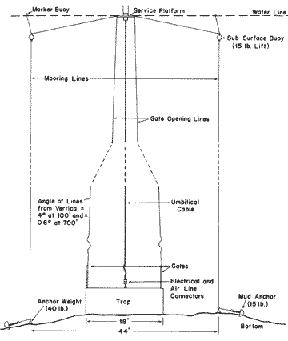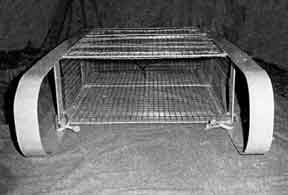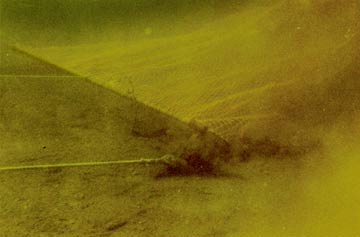The Loch Ness Project 
Loch Ness
Centre
Nessie Dead or Alive |
Back
to Reflections |
It was recently announced that Scottish Natural Heritage (SNH) was forming a Loch Ness Environment Panel........with a view to developing a code of practice for visiting monster hunters who might inadvertently cause damage to the loch's habitats, or individual creatures within it. This move was prompted by the proposal of a Swedish monster hunter and ufologist Jan Sundberg, to place a 6m long creel trap in Loch Ness. The SNH area manager Jonathan Stacey, made it clear that they had no policy on Nessie as such and the prime aim was to "protect the known from those pursuing the unknown". This is but the latest episode in a long interaction between those with responsibility for the loch and some of the unconventional activities which take place there. Scaffolding Cage 1933 Photograph *SMG Newspapers Ltd Reproduction without permission is forbidden without advance permission. To obtain permission please contact rights@smg.plc.uk  L.N.I.Large Eel Trap Early 1970's Copyright D. Raynor The Great Trap The next attempt was rather less sensational and came at the end of a decade of work by the Loch Ness Phenomena Investigation Bureau (LNI). Organised surface watches had failed to reveal the monster of popular expectation yet a huge volume of unexplained eyewitness testimony remained. Effort had moved underwater and thoughts were turning back to some of the original local "huge eel" ideas. In 1970, a study of the eel population was being made anyway, as one of the first attempts to incorporate some general biological research into the LNI activities. In addition to the eel traps, four "Great Traps" were made in case a small specimen of the larger quarry could be persuaded to enter. The traps were conical with the apex anchored to the bottom and measured 6ft high by 5ft across, with a spring loaded cover triggered by tension on a bait pouch inside. 
Bob Love'sProposed Trap Nothing
was caught but this did not deter The LNI
Scientific Director, the American, Roy Mackal
or the leader of underwater activities, Bob
Love. They proposed a number of traps 18ft
by 6ft by 6ft built of plastic tube, which
could be purged with compressed air to bring
them to the surface if successful (Mackal, 1976 p 382). The
traps would be anchored to the loch bed with
a service platform moored at the surface.
A radio alarm would be given if the trap doors
were triggered. This temporary isolation of
a specimen (for tissue sampling and photography)
was seen as the final objective but the LNI
left the field in 1972 with no funding forthcoming.
It was to be 1984, before Bob Love's idea was
tried by a Liverpool civil servant named Steve
Whittle who obtained support from the Vladivar
Vodka company.
His plans called for a huge trap to be winched
into the loch by a Chinook helicopter and
maintained for a month at a depth of 30ms.
His proposal to use live fish as bait raised
concerns with the Fishery Board. This was
because of the risks of introducing disease
and because escaping fish, brought from elsewhere,
might breed with the native stock, so affecting
the gene pool. This was the point at which
the Loch Ness Project became involved since
they were working with the board at the time,
on a number of fish studies.
Mr. Whittles scheme
was approved with the proviso that the Project
agreed to undertake design, construction and
deployment of the trap. This was perhaps the
first move towards the Environment Panel of
the year 2000.
Thus by a strange
irony, the Project, in return admittedly,
for what amounted to two years funding, found
itself with a not inconsiderable technical
challenge with an objective it found difficult
to take seriously.
Things
had moved on by then and even the most optimistic
expectations for the size of an unknown animal
would be nowhere near the specified 60ft.
length of the trap. But a lot had to be taken
seriously. To begin with, the Project might
be wrong and a great deal of the Project's
work has always revolved around this notion!
The trap would have to be built ashore and
be photographed, fly over Fort Augustus beneath
a small helicopter without breaking up and
be photographed, land on the water and be
photographed, and be immersed 30ms down for
a month. As if that weren't enough, it must
pose no threat to navigation or the loch's
known inhabitants and in the event of a successful
capture, should any harm come to the captive,
then it would be too late to say that the
eventuality had not been taken seriously.
In any case, there was the matter of professional pride!
Therefore, in a
field at Fort Augustus, a true monster emerged
in the shape of a great cylinder or "creel".
It measured 60ft long and 20ft in diameter
with doors at either end. It was made from
"pultruded" fibreglass tube, reinforced with
larger plastic tubes, designed to be very
slightly buoyant in the water and of course,
light in air. The triangular gaps between
the tubes were over a metre on the longest
side; quite sufficient to allow native fish
and otters to pass through. This was a year
before it was definitely established that
seals enter the loch. The tubes were secured
by ties and tape. In the event of a really
huge capture the degree of success could probably
be measured by the amount of damage to the
trap!
The Vladivar Trap 1984 "Lift Off"
The
above examples, may help to show just how
easy it is to cause damage, however inadvertently
and just how much thought should go into avoiding
it. Even the quest for dead monsters has its
dangers. The LNI did some dredging and trawling
in 1969 and the early 70's.
In 1978, Adrian
Shine of the Loch Ness Project said " If there
have been large live animals in Loch Ness
for the past six thousand years, then there
are large dead animals there now." The Project
had been searching for skeletal remains at
Loch Morar, using everything from glass bottomed
boats and divers to dredging trials up to
1000ft down.
However, in the
course of the Project's scientific work, an
unexpected community of invertebrate animals
had been found there, including some interesting
Ice Age relicts (Shine
& Martin 1988). Dredging was therefore
shelved and that was just as well, since the
Project's coring programme was showing how
valuable the undisturbed sediment was in its
own right, particularly in Loch Ness. Here,
the depth ensures that water currents are
slow, preventing re-suspension of the material.
The loch's faultline origins give it a remarkable
"trench like" profile with a very flat bed,
which prevents the mud from slumping.
All this adds up
to a particularly well stratified historical
record of national importance (Bennett
& Shine, 1993). Some of the work,
such as the ROSETTA Project, is concerned with cores up to 6m long
which contain a wealth of information on the
last 10,000 years but some of the most important
indications of human impact lie within the first few centimetres (Jones
et al. 1997).
When another "hunt
for Nessie's bones" proposed dredging in the
mid nineties, the Loch Ness Project made representations
to Scottish Natural Heritage regarding the
protection of the special stratigraphic resource
on the loch's deep basin floors. This issue
together with those introduced above, is to
be addressed by the proposed code of practice.
In
the meantime, it will help those proposing
to work on Loch Ness to bear in mind the following:
1. British Waterways have a right of unobstructed navigation throughout the length of Loch
Ness since it forms a part of the Caledonian
Canal.
2. Activities which
might result in the pollution of the loch
are the remit of SEPA (Scottish Environmental
Protection Agency)
3. The Ness District
Salmon Fishery Board is a statutory body
protecting angling interests and aquatic habitats.
The Board would be concerned with matters
which might be damaging to the native fish
population, particularly the migratory salmon
and sea-trout. The netting of fish in Loch
Ness is prohibited, as is the introduction
of alien fish, as bait for example. Even native
species, may harbour disease. Escaping fish
of farmed origin can also have adverse genetic
effects when breeding with the native fish.
The Clerk, Ness
District Salmon Fishery Board, York House,
20 Church St.,
4. The SSPCA (Scottish Society for the Prevention of
Cruelty to Animals) would have concerns
over the risks and treatment of individual
animals. Traps, for example could pose a risk
for air breathing mammals such as seals and otters.
Scottish Society for the Prevention of Cruelty to Animals (SSPCA), Braehead
Mains .603 Queensferry Road ,Edinburgh .EH4
6EA
5. SNH (Scottish
Natural Heritage) are responsible for the general protection of habitats within the environment
and would be concerned if there was a possibility
of introducing alien species, for example
as eggs or spores, on equipment which had
been previously used in waters elsewhere.
They, along with the Loch Ness Project, have also expressed concern for the preservation
of the deepwater sediments.
The Loch Ness & Morar Project have records of most previous activities at Loch Ness and are engaged
in a number of current programmes. We may
be able to assist with information, advice
or refer enquiries to others.
Copyright this page : The Loch Ness Project
|
|

